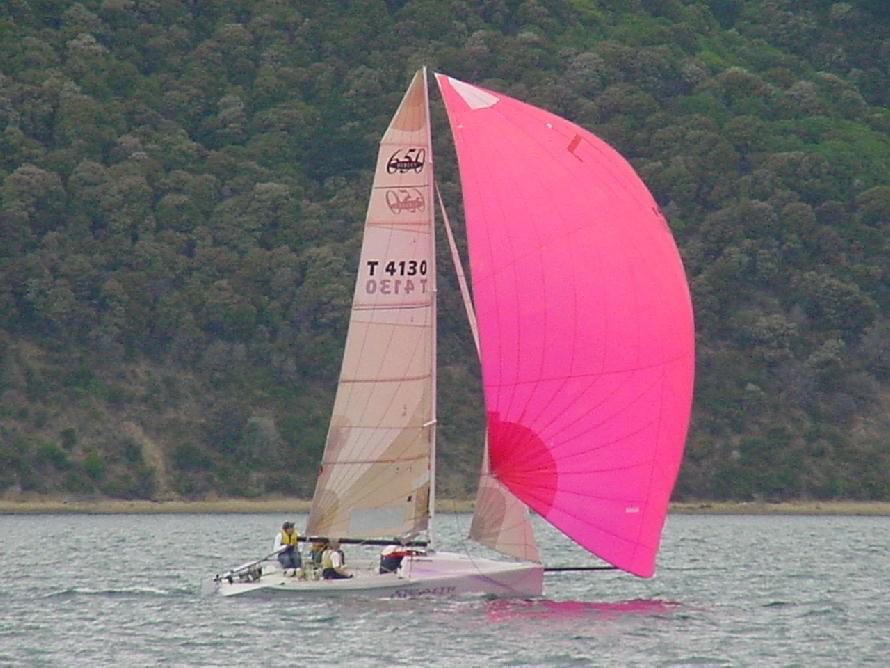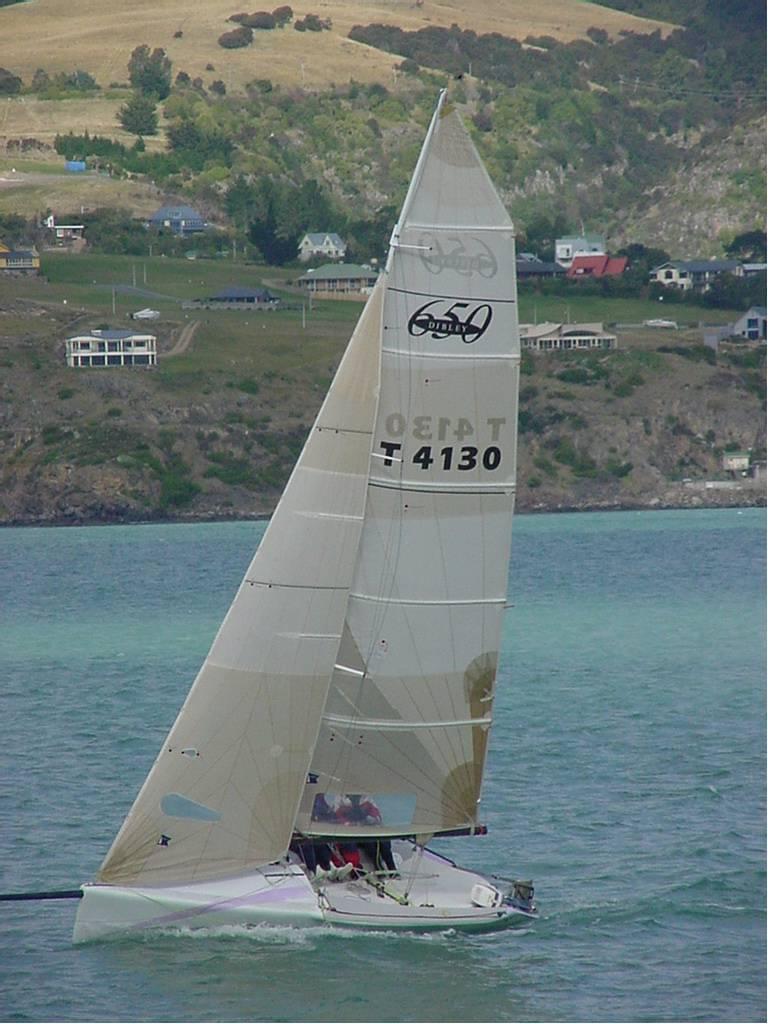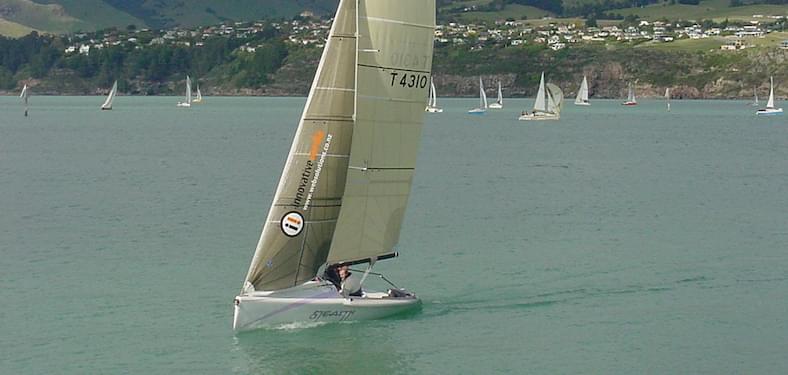
Dibley 21' Racing Trailer Yacht
Boat Name: StealthReview written for Boating New Zealand by Michael Cahill - April 1999:
Wind conditions for a test sail were almost ideal - 15-20 knots south-westerly. With a crew of four we had adequate power and opted for the no.2 jib. We waited for the camera boat by the Westhaven breakwater, then hoisted the masthead asymmetrical kite for a reach down to Stanley Point. Stealth immediately lifted out and planed at 10-12 knots, light on the helm and under easy control.

The spinnakers are set from a two metre long carbon fibre prod. The masthead kite was a little too full in the shoulders, but gave us an exhilarating and dry ride, easily outpacing the MRXs out for a Friday race.
The kite was dropped and bundled down the companionway before we ran out of water and we settled down for a beat back to the Harbour Bridge.

With the breeze now at 20 knots the no.2 was right at the top end of its range. Smith has found that the boat has to be sailed flat, with the main constantly played to achieve this. If she gets any large degree of heel then the leeward wing starts to dig in and slow it down.
Even with the main fully eased Stealth maintained an easy 5.7-6.0 knots to weather. There was almost no helm and she almost sailed herself upwind with little effort or fuss. The only complaints were from the older forward hands (this writer included), who had forgotten about the joys of hiking over the side dinghy style!
Back around the weather mark with the extra breeze we opted for the fractional kite, scavenged off one of Carl Smith’s 12 footers. Despite the reduced sail area, the heavier breeze and better sail shape resulted in an even faster ride, sitting on around 12 knots and peaking at 13 in flat water.
Smith’s top speed so far has been 18 knots. The whole performance was very dinghy-like, flat wake, fingertip control, wet and fun!
The non-Dibley designed rudder did have a noticeable hum and cavitation that will be fixed when it is replaced by a new foam carbon composite to Dibley’s design. This is a tapered teardrop shape with an almost pointed tip and a smaller chord than the existing ex-skiff rudder currently in use.

Overall Stealth has met both the designer’s and owner’s expectations. A fast, fun boat with all the modern go-fast gear at a relatively modest cost, around $32,000.
Dibley also has a similar concept “750” currently sailing very successfully up North. This has a fixed keel rather than a centreboard but has a similar hull shape and ‘wingspan”. To date, she has collected as many guns as she has had starts.
Nearly 30 years ago a young designer blitzed the New Zealand keelboat yachting establishment with a radical design that was significantly smaller, lighter and faster and cheaper than the opposition. It also relied more on crew weight, had a fractional rig and was only a quarter of the cost of the “lead mines”. That revolutionary approach by Bruce Farr for his first keeler - the half-tonner Tituscanby - is even more evident in the design approach Kevin Dibley adopted for the new trailer sailer for Tauranga owner Carl Smith.
The Dibley 21's critical design parameters were an overall length of 6.5 m, a maximum beam of 2.5 m and a sail area of 30 sq m. In maximising the sail area to displacement ratio, Dibley paid special attention to the deck layout and crew positions to ensure that both the fixed ballast and crew weight was concentrated around the boat’s centre of buoyancy. This minimises pitching. Total displacement is only 680 kg. This includes an allowance of 240 kg for crew and 200 kg in the bulb keel.
The final sail area to displacement ratio is an amazing 39 which compares with typical high performance trailer sailers at 26 or racing keelers at 28.
The other major design consideration was the hull shape. Here, Dibley used the resources of the VPP computer modelling package to determine the ideal maximum waterline beam, with the right shape to mould the trailerable width wings (which utilise the righting effect of that crew weight).
The hull shape is also slightly hollow in the entry to reduce drag and minimise the bow wave. The shape then fairs into a flat run aft for planing performance.
The layout and set up is very simple. No winches, just double purchase on the headsail halyard and sheets, with two Harken ratchet blocks each side to take the spinnaker loads. The main, no.2 and masthead asymmetrical spinnaker are all from the Boyd and McMaster loft, with the no.1 and no.3 made in Technora cloth by Doyles.
When first launched, Stealth had a semi-circular deck mounted vang, however Smith has now replaced it with a “49er” style arrangement. This has reduced clutter and makes it easier for the crew to scramble under the low boom when tacking or gybing.
The boom is very low to keep the centre of effort as low as possible and reduce the heeling moment. The other advantage of the vang system is that vang tension remains the same no matter how the mainsheet is trimmed. With most conventional systems, vang tension increases as the main is eased and therefore requires constant adjustment to maintain sail shape. The mainsheet is also a ratchet block system attached to a full width traveller.
All deck gear is Harken.
The hull was built in Airex foam, moulded over a temporary male mould and then glassed in E-glass unidirectional cloth with kevlar reinforcing at stress points, frames and bulkheads.
The deck is a similar laminate but incorporates Divinicell rather than Airex foam. The laminate and lay-up were specified by High Modulus and are suitable for amateur or home building. So while it is still high tech, it does not require vacuum bagging or autoclave heating.
A professionally built boat using these techniques would probably be slightly lighter, but Dibley estimates it would also add another $7-10,000 to the cost.
The rig is a carbon fibre mast designed by Chris Mitchell of Applied Engineering. The carbon fibre boom is from C Tech. The lightweight rig has a lower centre of gravity than alloy, resulting in less pitching that slows boats down.
The resulting rig is light and flexible with the top section almost self de-powering in gusty conditions.
Stealth is currently being sailed out of Port Denarau Marina in Fiji.
Over-all results: 1st on line winning 6 out of the 7 races
SPECIFICATIONS AND PRINCIPAL DIMENSIONS
LOA 6.500 m 21’ - 4”
LWL 6.000 m 19’ - 8”
Overall Beam 2.500 m 8’ - 1”
Draft 2.000 m 6’ - 6”
Displacement (1/2 load) 680 kg’s 1,500 lbs
J 2.300 m 7’ - 6”
I 8.100 m 26’ - 7”
P 9.300 m 30’ - 6”
E 3.000 m 9’ - 10”
Disp/Length 88
SA/disp 39
PO Box 2836
Wakatipu
Queenstown, 9349
New Zealand
Tel +64 (0)275 933 692










